| |
"There's no such thing as a genuine psychic – there are psychics who con others and those who con themselves." |
| |
Abhijit Naskar, neuroscientist and author |
It's not often that I encounter an opening scene that feels more like the finale, but that's absolutely the case with the 1948 Night Has a Thousand Eyes. In a train yard on the blackest of noir nights, a well-dressed man looks worriedly around him, then leans down to retrieve a woman's glove from the ground. As Victor Young's score assures us in no uncertain terms that someone is in danger and that time is of the essence, the man continues his search and finds a discarded handbag, the contents of which are scattered around. I'm not sure how this played to an audience of the day, but this instantly rang alarm bells for me, having years ago worked with ambulancemen who told of female suicide victims who had carefully placed or discarded their personal belongings before throwing themselves off high places to their deaths. Turns out I was right. Seconds later, the man spots a woman climbing steps to a tall signal gantry and gives immediate and urgent chase. Then, as the woman prepares to throw herself in front of an approaching train, the man grabs her and pulls her away from the gantry edge. "Why did you stop me?" the woman tearfully asks, to which the man replies with conviction, "It's alright, Jean, everything is alright!" Only at this point did I realise that this was no chance encounter where a passing stranger saves the life of a random woman, one convention dictates that he should then fall in love with. These two know each other, confirmed when the woman also addresses the man by his first name. As the man comforts the woman and the two walk to a waiting car, the previously urgent score switches to the sort of romantic resolution music that you half-expect to build to a final crescendo as the words 'The End' fade up on screen in an attractively cursive font. But this is not the end, and while my subsequent expectation that we would soon be hopping back in time to discover what brought the woman to this desperate moment was indeed met, it turns out that we're only midway through this particular story.
The woman is Jean Courtland (Gail Russell) and the man is her fiancé Elliott Carson (John Lund), and maybe it's just me, but Jean seems to recover from her suicide attempt a lot quicker than you'd think someone in her position actually could, but such are the casualties to expedience of 1940s American cinema. What apparently drove Jean to this desperate act was the fanciful notion that the stars of the night sky were all eyes looking down at her (hence the title), to the point where she could not stand it any longer. Elliot suggests a coffee and some food, and the two drive to a lively venue that differs from the movie norm of the day by being run, staffed and partly patronised by Chinese Americans. Once inside, Elliot steers Jean to a table where a man named John Triton (Edward G. Robinson) is waiting. As soon as Jean sees him, she realises that this is how Elliot knew where to find her. Jean assures Elliot that John has been trying to help her, but the testy Elliot is having none of it, labelling John as a confidence trickster and insisting that he explain himself to the police, a suggestion that John seems willing to go along with. What, you might be justified in wondering, is going on here?
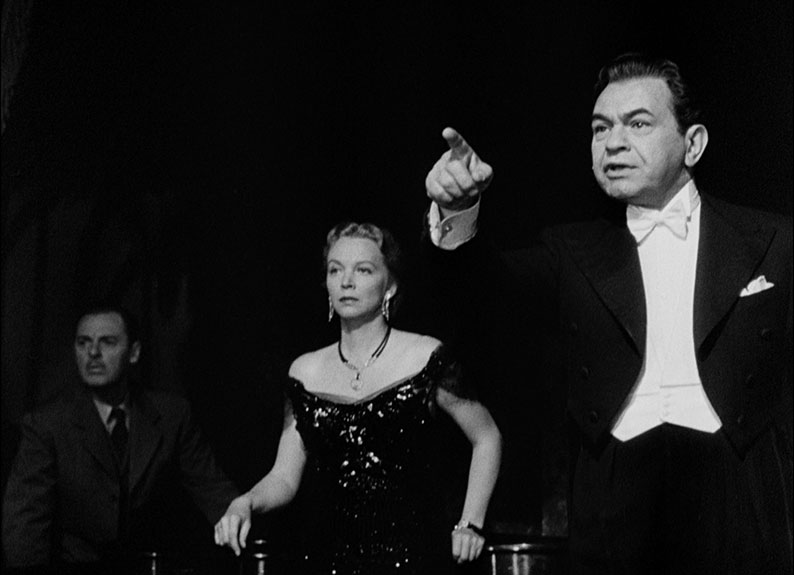
It's at this point that the predicted and extended flashback begins, as John relates his backstory to Elliot in the hope of convincing him that he is not the fraud that he seems to think he is. John, you see, used to make a living as a mind-reader, a stage act that he admits up front relied on the sort of trickery that such acts have long since been discredited for using. I'll still give props to John for originality, as instead of being vocally being fed coded information by his assistant and fiancée Jenny (Virginia Bruce), he gets it from the tunes that his friend and associate Whitney Courtland – aka Court (Jerome Cowan) – plays on the piano as atmospheric accompaniment. Neat, huh? Quite how he gets specific names and addresses from this is beyond me, but then it's their scam not mine, and one they've presumably been honing for some time. Then, midway through impressing the audience, John suddenly experiences a vision out of nowhere that compels him to tell a woman in the audience to go home immediately because her child is in trouble. After the show, John, Whitney and Jenny are discussing their increasingly rocky financial situation when warned woman reappears and confirms that she arrived home just in time to save her son from being burned alive. He was still injured and is now in hospital, and the woman wants to know if he'll be alright, to which John replies in genuine bemusement, "I don't know." As he ponders on this new turns of events, Court reveals that an member of the audience at a previous show who ignored John's warning not to drive home ended up in hospital with a broken collarbone after his car went off a bridge. John dismisses the suggestion that this may be anything more than a chance thing, then unexpectedly has another prediction in which he picks the likely winner of a horse race that Whitney is considering placing a bet on. Again he dismisses this as a joke, only to later discover that Whitney has bet their remaining money on the horse regardless, one that has landed him a $200 win.
The notion of a fake medium who turns out to have real visions is one that's been recycled several times in subsequent years, perhaps most famously by Whoopi Goldberg as sham clairvoyant Oda Mae Brown in the 1990 mega-hit Ghost. And while there is a suggestion on the special features of this disc that Night Has a Thousand Eyes was the first film out of the gate on this score, as I watched it for what I was convinced was for the first time I was plagued by a strong sense of déjà-vu. Maybe I had seen it after all when I was younger, I mused, but if so, how the hell did I forget that opening sequence? Moreover, the memory was strong enough to convince me that I'd not just seen the film, but written about it. A few seconds later it came to me. It wasn't this film I was recalling, but the 1938 British film The Clairvoyant, in which a young Claude Rains plays Maximus, a small-time mind-reading act whose musical-hall debut runs into trouble when his assistant is accidentally locked out of the hall and unable to feed him the necessary vocal cues. As the audience mocks him, he suddenly has a vision that enables him to read the contents of a letter in the pocket of a heckler. The similarities to Night Has a Thousand Eyes do not end there. Later, Maximus is able to predict the winner of the National Derby and foresee that train will fatally crash, and at one point it is suggested that he might actually be the cause of the tragedies he predicts, a notion that also features strongly here. That both John and Maximus find their purported powers the subject of legal investigation and scepticism is also noteworthy, with a logical explanation for every prediction that John has made provided by no-nonsense detective, Lieutenant Shawn (William Demarest). Despite these similarities, Night Has a Thousand Eyes is not a remake of the earlier film, but an adaptation of a novel of the same name by Cornell Woolrich, whereas The Clairvoyant was based on book by Ernest Lothar. You can read what you like into the fact that Woolrich's novel was written ten years after The Clairvoyant first hit cinemas, and thirteen years Lothar's tome was first published.
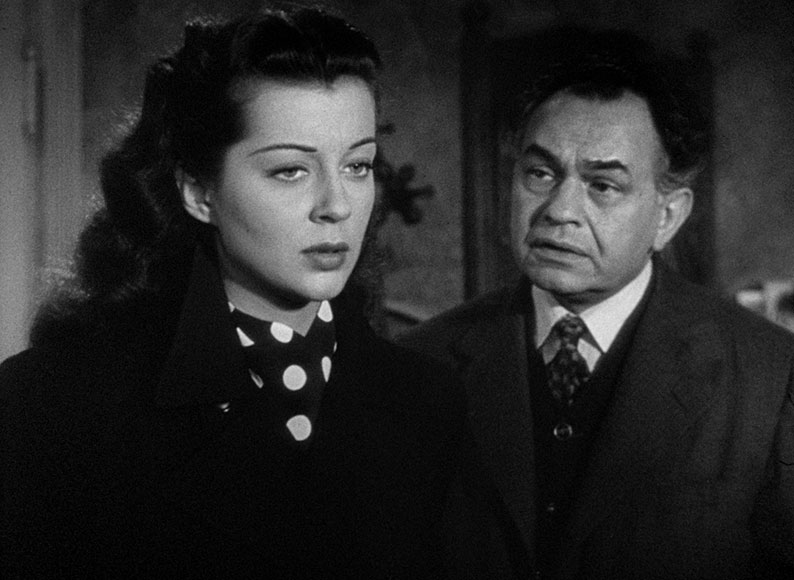
This aside, Night Has a Thousand Eyes then goes its own interesting way with this central concept. A tragedy involving a young newsboy awakens John to the possibility that his predictions might be self-fulfilling prophecies, and his terror at a vision in which Jenny dies giving birth to their son prompts him to unceremoniously pack his bag and disappear, leaving her in Court's care in the hope of changing the course of this predicted future. By this point it's been revealed that Court and Jenny married that Jean is their daughter and that Jenny did indeed die giving birth to her, an early suggestion that the future event envisioned by John will come to pass whatever precautions might be taken.
After years hiding out in a deserted gold mining town, a newspaper story alerts John to a new headquarters being built in Los Angeles by his former friend, Whitney Courtland, who it turns out had acted on a prediction made by the distracted John just before his departure that ultimately made him a fortune in the oil business. Having decided on a whim to travel to the city, John sets himself up in a quiet boarding house close to Court's new skyscraper, paying the bills by selling magic trick supplies by mail order, the 1940s equivalent of setting up a small business online today. On the one occasion he risks getting close to Jenny and her father he has another vision, one that predicts Court's possible death in an airplane crash. It's at this point that he decides to break cover in an effort to persuade Jean to warn her father not to fly, but by the time she calls the airport his plane has departed and is soon reported missing. It's then that John has the vision that brought them all to this point, that of Jean lying dead under the stars at night, information she teases out of him after realising that he holding back something serious he has seen about her.
It's a lot of setup and backstory to get us to a second half that plays like a combination of detective thriller and whodunnit, which is given a supernatural flavour by further intermittent visions experienced by John, one of which furnishes him with an exact time and date of Jean's impending death. Despite John's determination to protect Jean from harm, Elliot remains convinced that he is up to no good and takes the whole story to the police, and with Jean now the heiress to a considerable fortune, the aforementioned Lieutenant Shawn and a squad of men are assigned to protect her and keep a watchful eye on John.
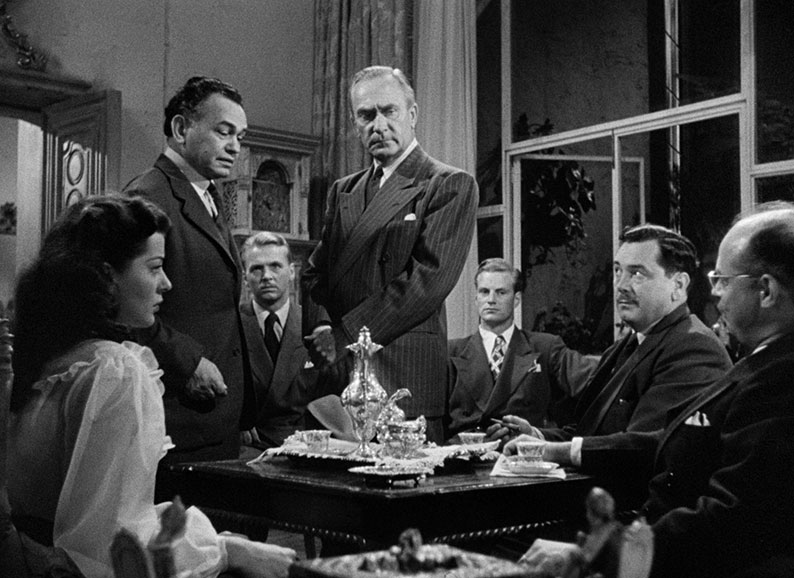
Preposterous though the whole notion of second sight might seem in the real world, it's disarmingly easy to buy into it within the framework of this seductively crafted thriller. Central to this is the ever-excellent Edward G. Robinson, whose line delivery, body language, and pauses for reflection have such a natural feel that they almost convinced me that his abilities were real, and they make John an easy character to like and trust from an early stage. It helps that the suspicious Elliot, although solidly played by John Lund, is the sort of straightlaced dullard of a leading man that always has me wondering what his female counterpart ever saw in him. As Jean, Gail Russell is more sympathetic, enough at one point to have me hoping that John's psychic antenna was off target for once, and that his prediction of her demise would prove to be a psychic miscalculation. Given that the film was made in Hollywood in the 1940s you'd certainly think she would be safe, but there are scenes here that have the dark paint of noir all over them, making it quite possible that all bets are off. The leads are backed by solid supporting cast, the most enjoyable of whom is William Demarest as the distrustful Lieutenant Shawn, though I did develop a soft spot for Henry Guttman's sour-faced butler, Preston, who does make his few brief appearances count. My favourite comes when he almost spookily opens the door to the house just as Shawn is about to knock. "What's this, the magic eye?" Shawn cynically asks one of his men, only for Preston to reply, "I just happened to be looking out of the window, sir."
Woolrich's novel was adapted by British playwright Barré Lyndon (oh, that name) and American screenwriter Jonathan Latimer, and was directed by John Farrow, a sometimes undervalued filmmaker who scored a noir bullseye the same year as this film with The Big Clock, also co-written by Latimer. While the screenplay keeps things on the move and hands Robinson the best monologues and Demarest the cynical wisecracks, it's Farrow, in partnership with hugely prolific and talented cinematographer John F. Seitz – he of Sullivan's Travels, This Gun for Hire, Double Indemnity, The Lost Weekend and so many more – that give the film its flair and its seductively noirish atmosphere. Farrow's blocking of the actors, coupled with Seitz's arresting use of the Academy frame, particularly on group wide shots, is of the highest order here, and when the camera moves, it does so with purpose and style. The result is an entertaining, smartly made and impressively performed work that too often gets overlooked in the discussion of the 1948 film for which Farrow is still rightly heralded, in whose mighty shadow this film has for too long languished. It deserves to be seen and judged on its own considerable merits, and if you're a fan of the film work of Edward G. Robinson and want to see him play the flipside of the tough guy persona for which he became famous, Night Has a Thousand Eyes should be considered essential viewing.
The 1080p transfer on Indicator's Blu-ray has been sourced from an HD restoration by Universal, created from a 2K scan of a 35mm finegrain print in 2021 in the film's original aspect ratio of 1.37:1. The transfer itself is a solid one, with a decent contrast range and the inkiest of black levels, and while there are faint traces of former wear in places, they have all been severely reduced, and dust spots have been largely eliminated. Where the image falls a tad short of expectations is in the area of sharpness and fine detail definition. Don't get me wrong, it's still highly watchable and is crisper in some areas than other, particularly facial close-ups and mid-shots, but it is gernerally just a touch softer than the standard set by the best restorations of films of this period.
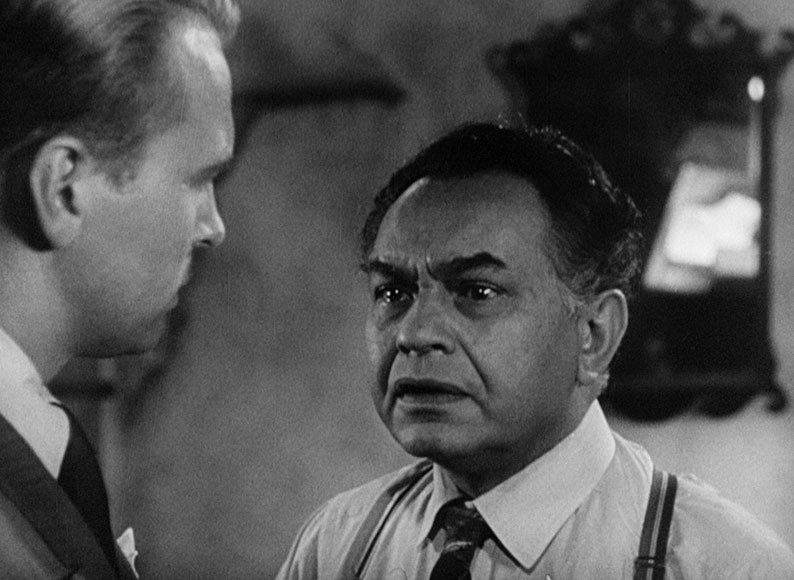
The Linear PCM 1.0 mono soundtrack also has its small issues. While the tonal range is inevitably narrow, the dialogue is always clear and even the more strident elements of Victor Young's music score do not distort, but there's a clearly audible background hiss and fluff that varies in volume, but on occasion can get quite loud. Speaking personally, I quickly got used to it and didn't even notice it after a while, only recalling it when I popped the disc back into the drive to recheck the sound and vision specs.
Optional English subtitles for the deaf and hearing impaired are available. I'm sure you had a vision that this would be the case.
Audio Commentary with Glenn Kenny and Farran Smith Nehme
Authors and critics Glenn Kenny and Farran Smith Nehme take a detailed look at the film, its cast and its makers, with Kenny usefully drawing comparisons with Cornel Woolrich's source novel, from which he also intermittently quotes. There's quite a bit on Edward G. Robinson and screenwriter Jonathan Latimer, and even more on director John Farrow, some of which I found interesting, though I will admit to drifting off a bit during the extracts from his daughter Mia's autobiography about Farrow family life. I'm sure some will find this fascinating. The claim from Kenny that the notion of the fake psychic who discovers he has real powers was more or less the invention of John Latimer prompted a small double take on my part, and seemed to confirm that neither he nor Nehme have seen The Clairvoyant, which is also not included in a list of films featuring second sight that the two later roll off. There's plenty of interest here, nonetheless, including an almost comically theological extract from a review of the film from an unnamed Catholic publication.
Between Heaven and Earth: Tony Rayns on 'Night Has a Thousand Eyes' (23:38)
The always fascinating Tony Rayns admits up front to being "one of the paid-up founder members of the John Farrow Appreciation Society," and provides an overview of the director's chequered career and his contradictory life as a religious man who wrote a book on Catholic papacy but who was also an unrepentant womaniser. He also delivers an interesting appreciation of the film and particularly Farrow's way with framing and camera moves, as well as praising the performances of Edward G. Robinson and William Demarest. We're clearly of the same mind about these aspects. He sums the film up by describing it as a rather satisfying entertainment, though not as good as the same year's The Big Clock. Someone had to say it.
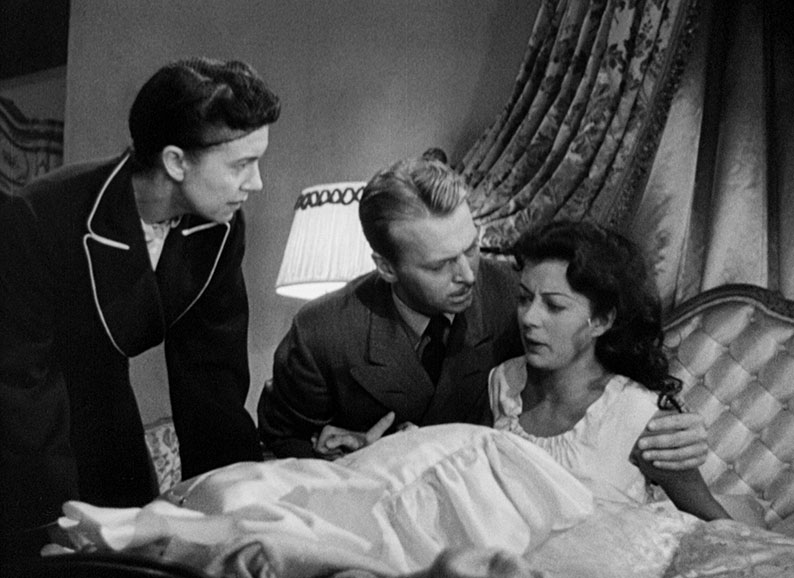
Screen Directors Playhouse: 'Night Has a Thousand Eyes' (1948) (30:01)
A supremely efficient and fast-paced compression of the feature into a half-hour radio play, one that follows the plot of the movie but dispenses with a number of scenes and dialogue exchanges. It thus shouldn't really come as a surprise that this was also directed by John Farrow and stars my two favourite actors from the film, Edward G. Robinson and William Demarest. Farrow introduces the film after a biographical build-up from an unidentified announcer, and teams up with Robinson and Demarest for a jokey footnote at the end. Nicely done all round, though since this take on the story opens with the scene that ends the film, I'd give it a wide berth until after you've watched the original.
Suspense: 'The Man Who Thought He Was Edward G. Robinson' (1946) (28:11)
An episode of the radio series Suspense in which Edward G. Robinson stars as both himself and henpecked husband, Homer J. Hubbard, who reasons that he looks and sounds a little like the actor, and after a viewing of Little Caesar starts imagining that he is him, or at least the person he believes him to be from his tough guy screen persona. This is soundly mocked by his wife Ada, who misses no opportunity to loudly put him down, telling everyone she knows about her husband's delusions so they can all have a good laugh at him too. So wrapped up in his fantasy is Homer that he decides to murder Ada and make it look like suicide, and when the opportunity unexpectedly arises to meet the real Edward G. Robinson, he approaches him for advice and help with his plan.
This is a fascinating piece that is simultaneously very much a work of its time – the presentation of Ada as a relentlessly nagging shrew has not dated so well – and unknowingly forward-looking to a time, many decades later, when name actors will happily parody their own image and play fictionalised versions of themselves. An initially intriguing plot takes a frankly suspect turn once Homer and Robinson meet, but considering that this was likely broadcast live, Robinson does a phenomenal job of playing both characters in breezy conversation with each other whilst keeping each of the characters distinct. The show is sponsored by Roma wine, and so relentlessly is this pushed – several times the word 'Roma' is spelt out by the announcer so that you won't forget – that you'd have to be asleep not to realise this. The play is even interrupted at one point for another hammer-it-home push of this product, a moment that will have a familiar ring for anyone who's watched YouTubers put their videos on pause to shamelessly hawk the trash being pushed by that episode's sponsors.

Theatrical Trailer (2:19)
A trailer narrated and introduced by actor John Lund, who kicks off by reading the poem by poet Francis William Bourdillon, from which the title of Woolrich's source novel was presumably taken, then attempts to establish the legitimacy of second sight by relating it to experiences that the viewing public might have had. A few extracts from the film follow, plus a big overlaid caption that claims, "The whole country is singing its praises." Not that Catholic journal quoted in the commentary, mate.
Image Gallery
32 screens containing crisp monochrome promotional stills – including a few posed and lit portraits – some coloured-in lobby cards, pages from the Paramount press book, close-ups of press clippings, details of a 'National "Eyes" Contest', and two posters.
Booklet
Following credits for the film, writer and researcher Jill Blake delivers an enthrallingly comprehensive look at the life, career and political activism of leading man Edward G Robinson. A page peppered with clippings of lightweight puffery supplied by the studio to newspapers as small space-fillers is followed by a profile of actor John Lund from a July edition of the New York Daily News written by columnist Wanda Hale. Co-star Gail Russell is the subject of a profile by Edwin Schallert from a January 1949 edition of Los Angeles Times, after which is an interview with screenwriter Jonathan Latimer from a May 1948 edition of the Los Angeles Daily News, in which talks about his work and his collaborations with John Farrow. Bringing up the rear are three contemporary critical reviews, which range from cautiously positive (Monthly Film Bulletin) to contemptuously dismissive (Pittsburgh Sun-Telegraph). As ever, the booklet is attractively produced and illustrated with promotional material from the film.
An entertaining, smartly directed, noir-tinged psychic detective tale with a fine central performance from Edward G. Robinson and some enjoyable work from the supporting cast. A decent restoration from a not quite pristine quality source has been solidly transferred here and is backed by a typically fine collection of special features – I particularly enjoyed the radio plays, and it's not often I get to say that. If you've not picked this one up already, I have no problem warmly recommending it.
|